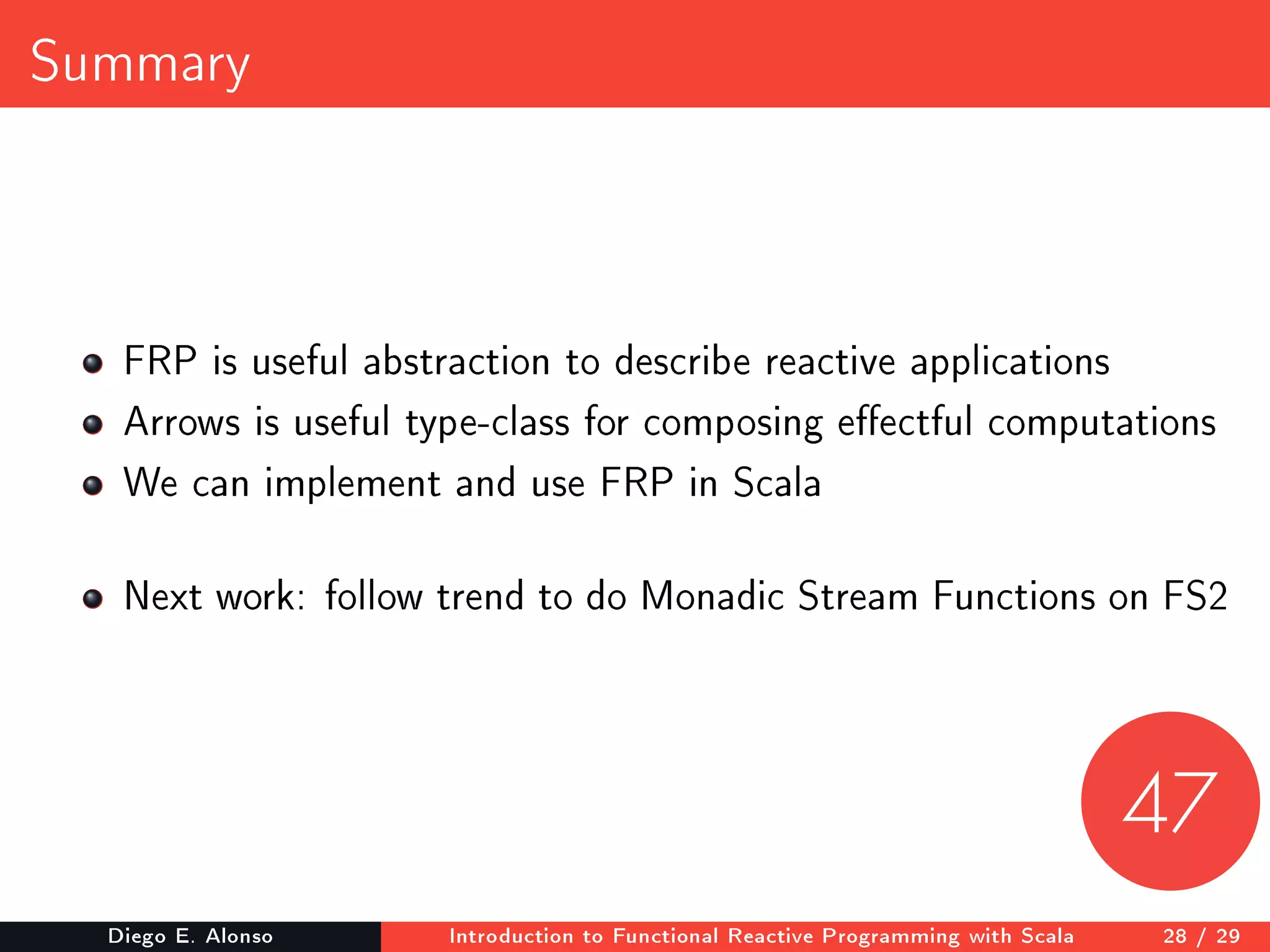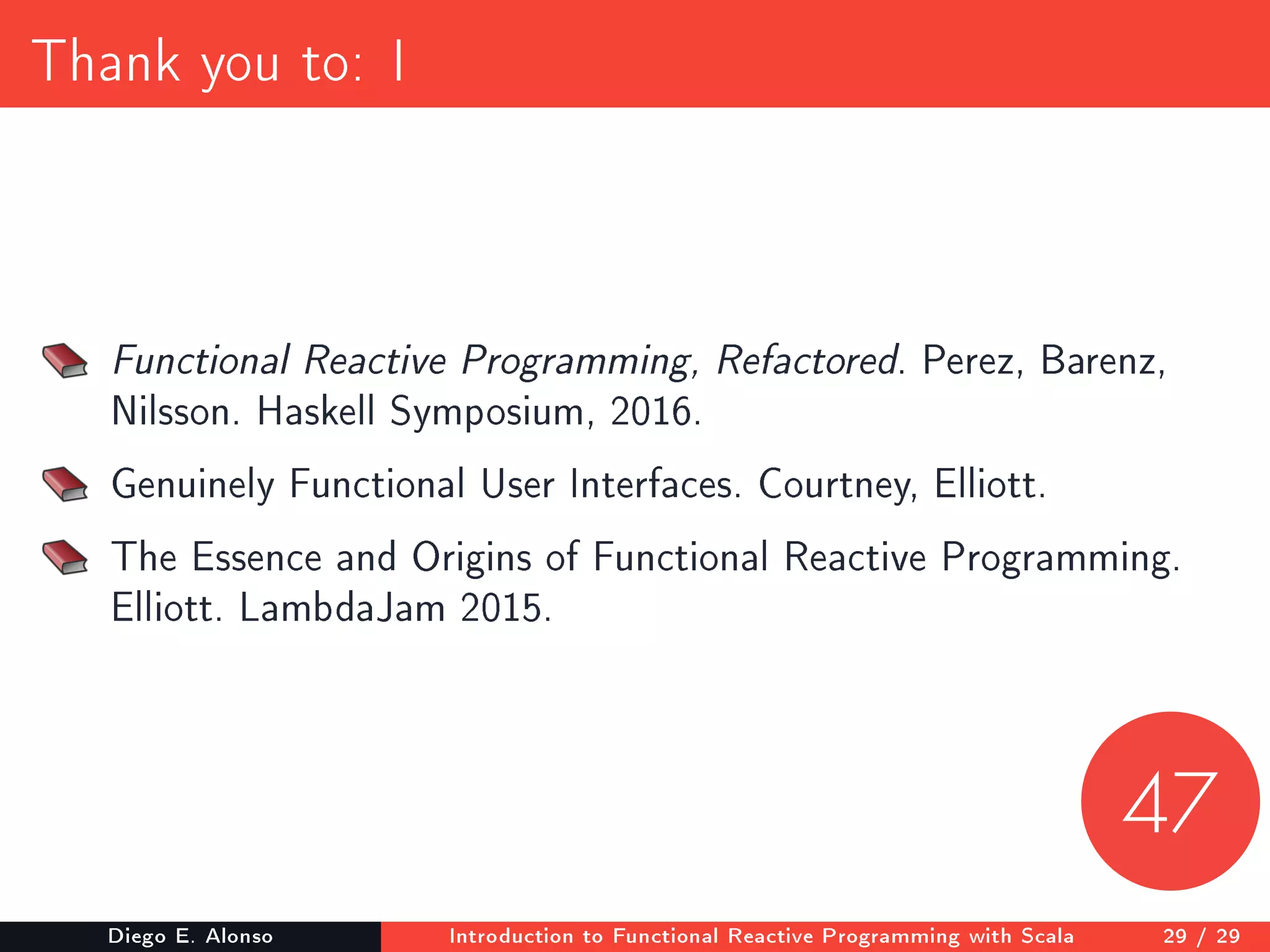The document introduces functional reactive programming (FRP) with Scala, emphasizing its principles, applications, and how it differs from traditional programming paradigms. It covers the concepts of states, timing, streams, and the implementation of arrow type classes for compositional programming. The author suggests that FRP is a valuable abstraction for developing reactive applications and calls for further exploration of monadic stream functions in Scala.
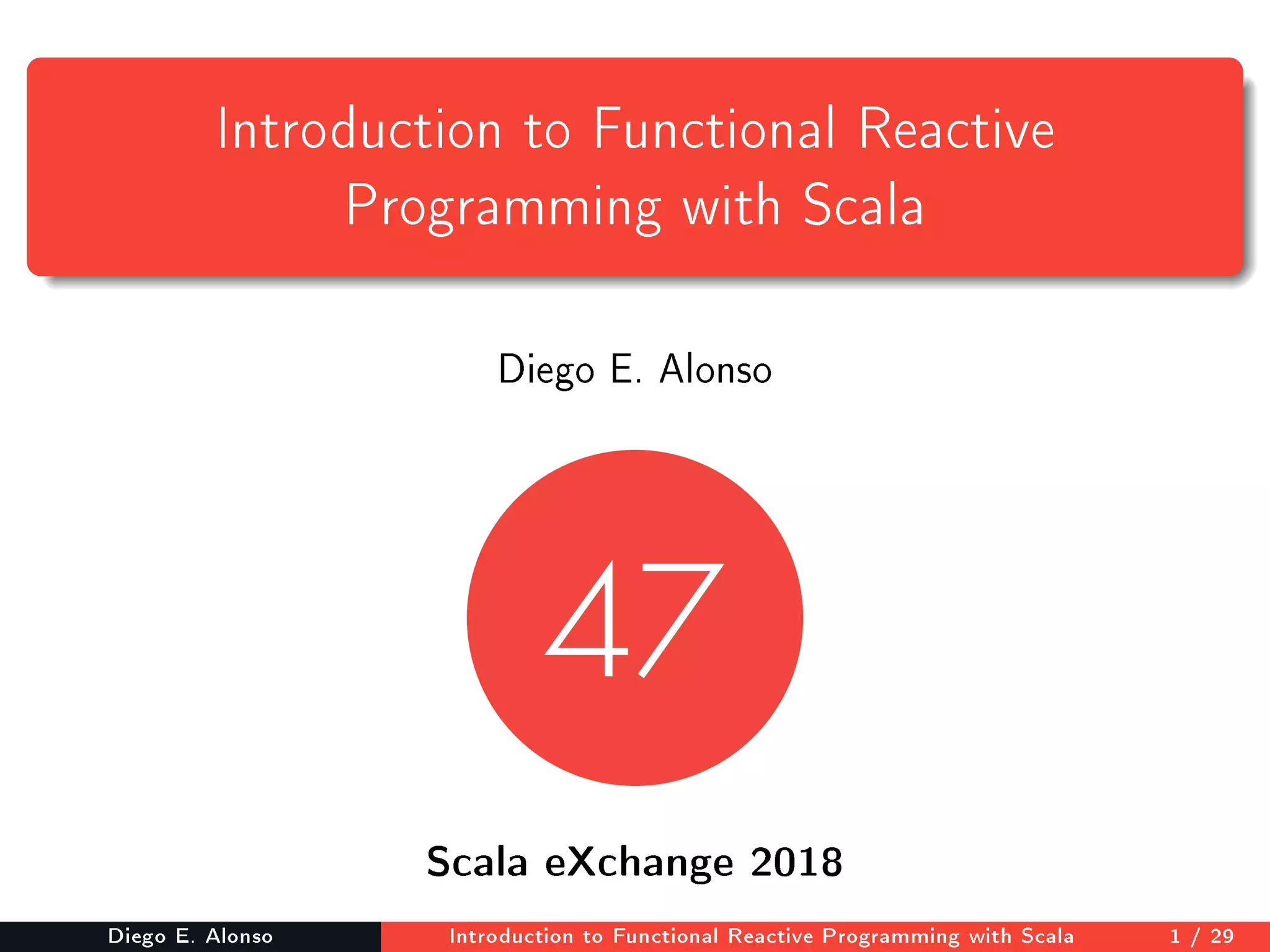
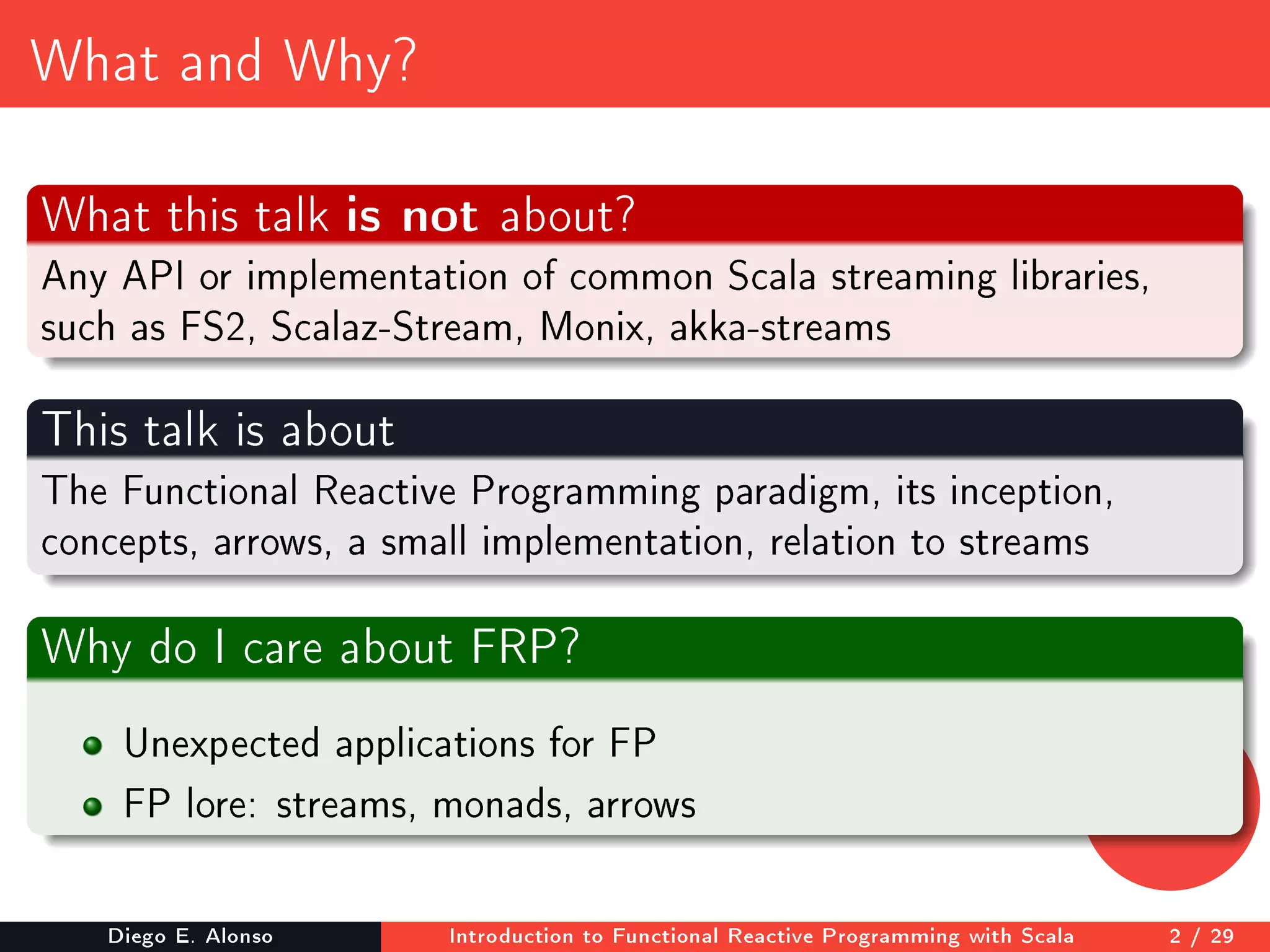
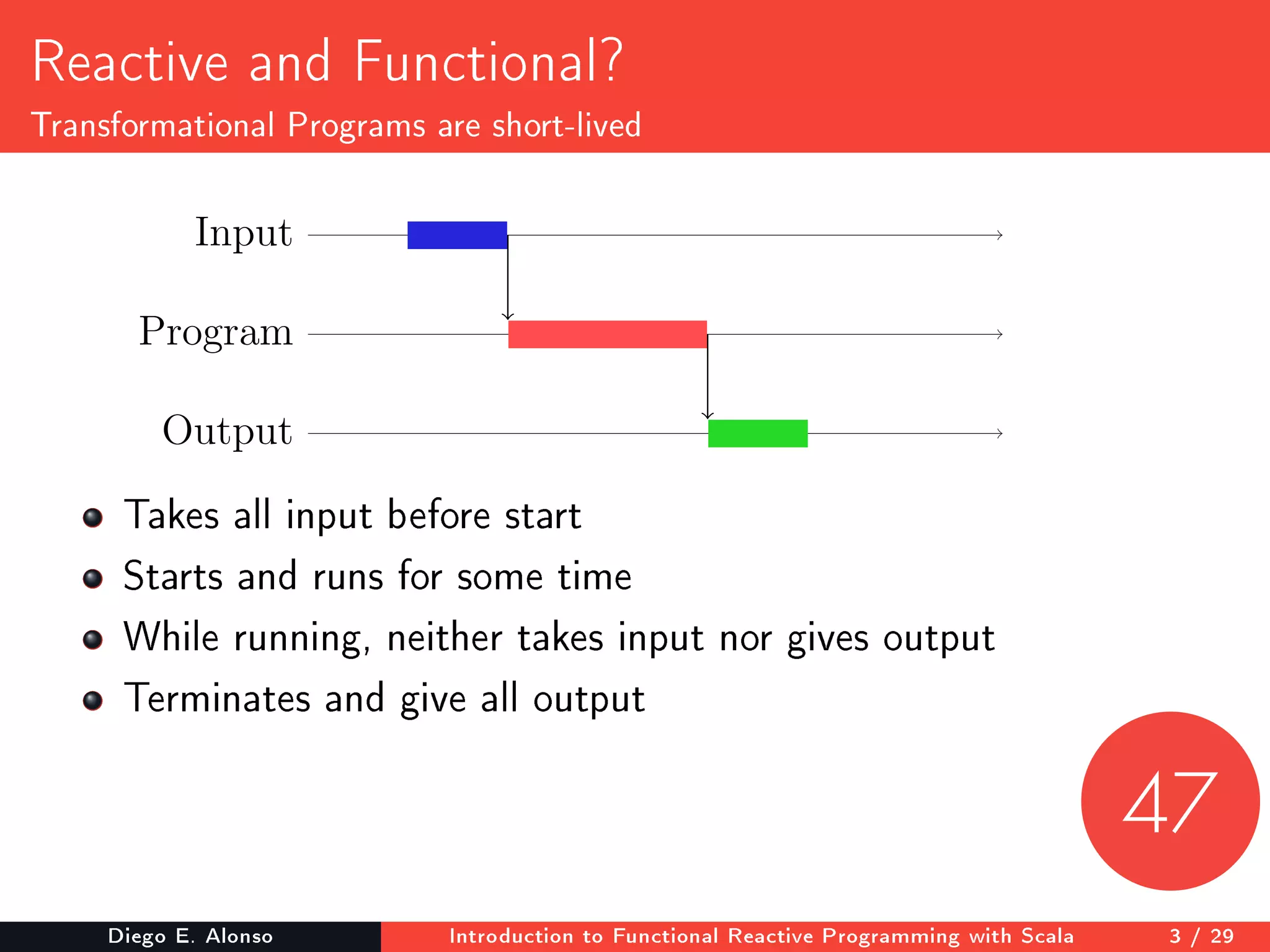
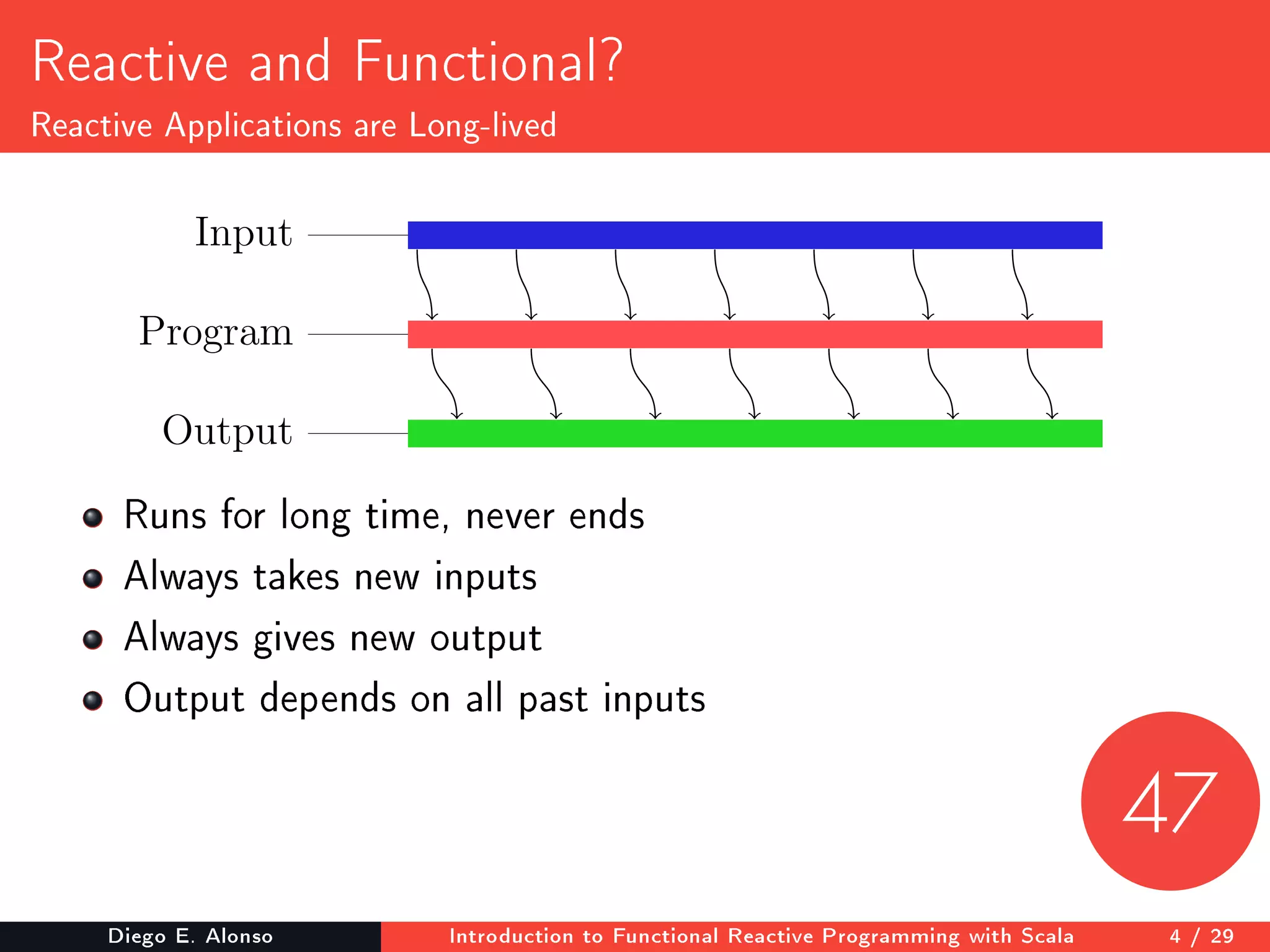
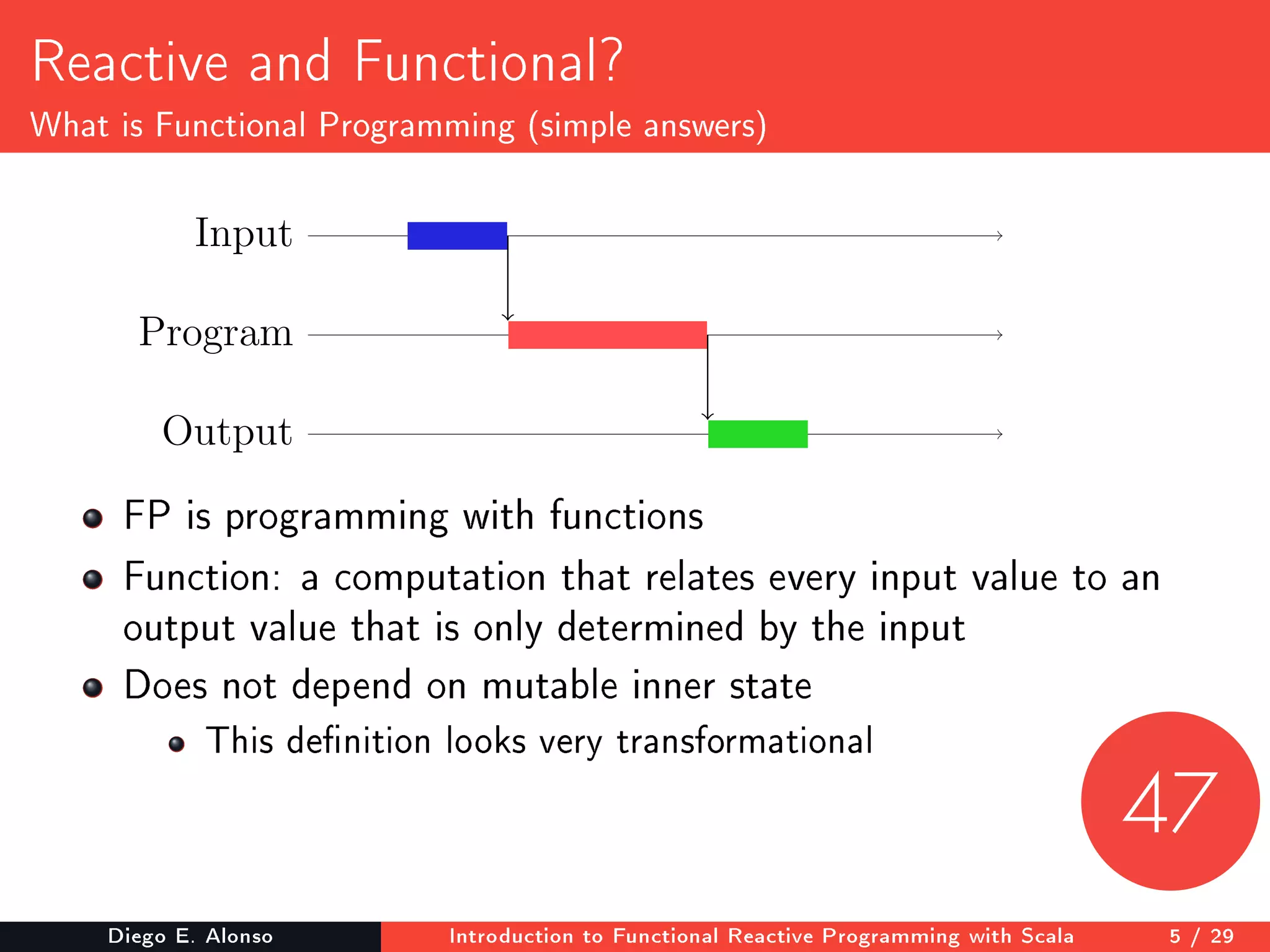
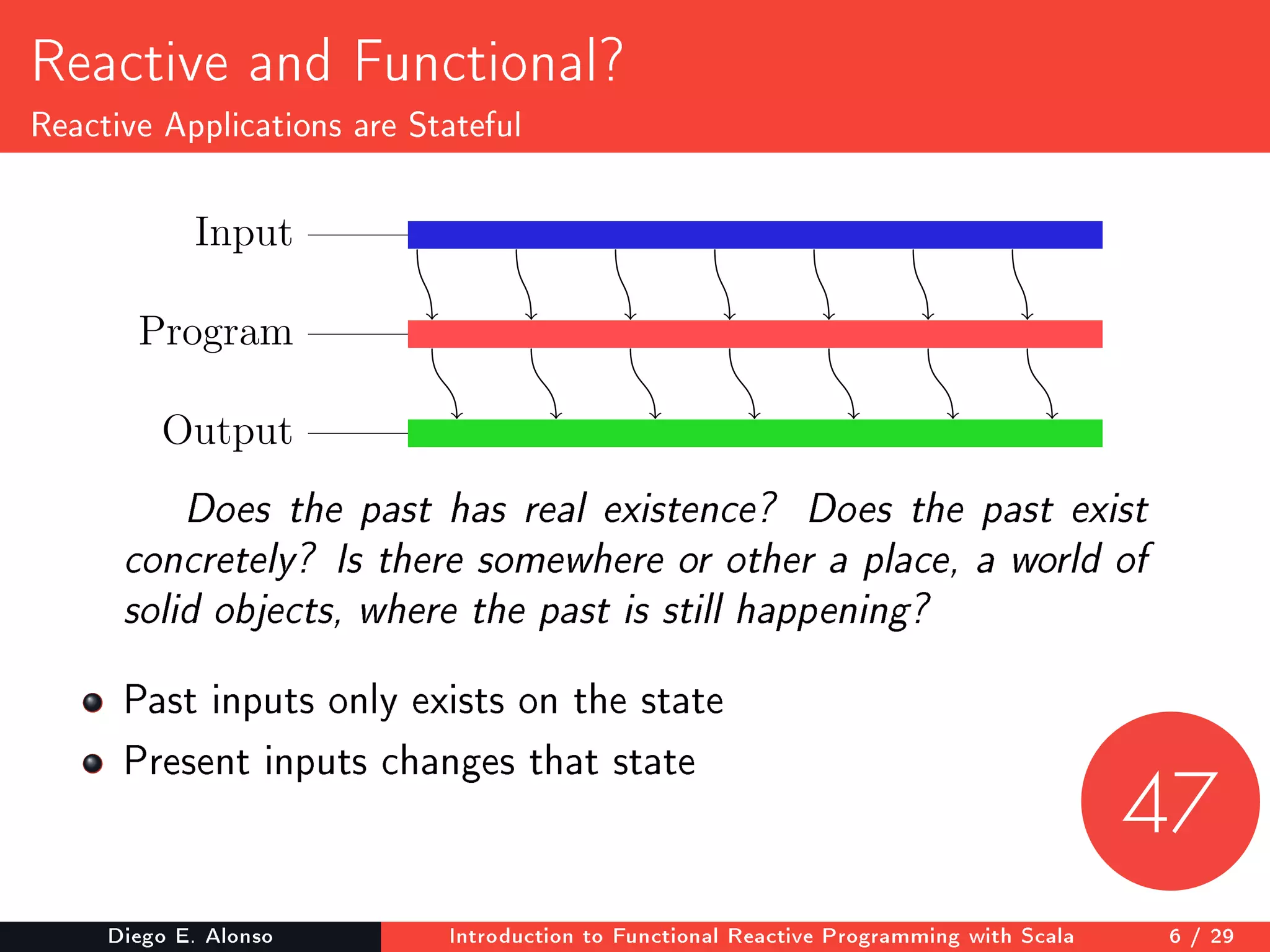
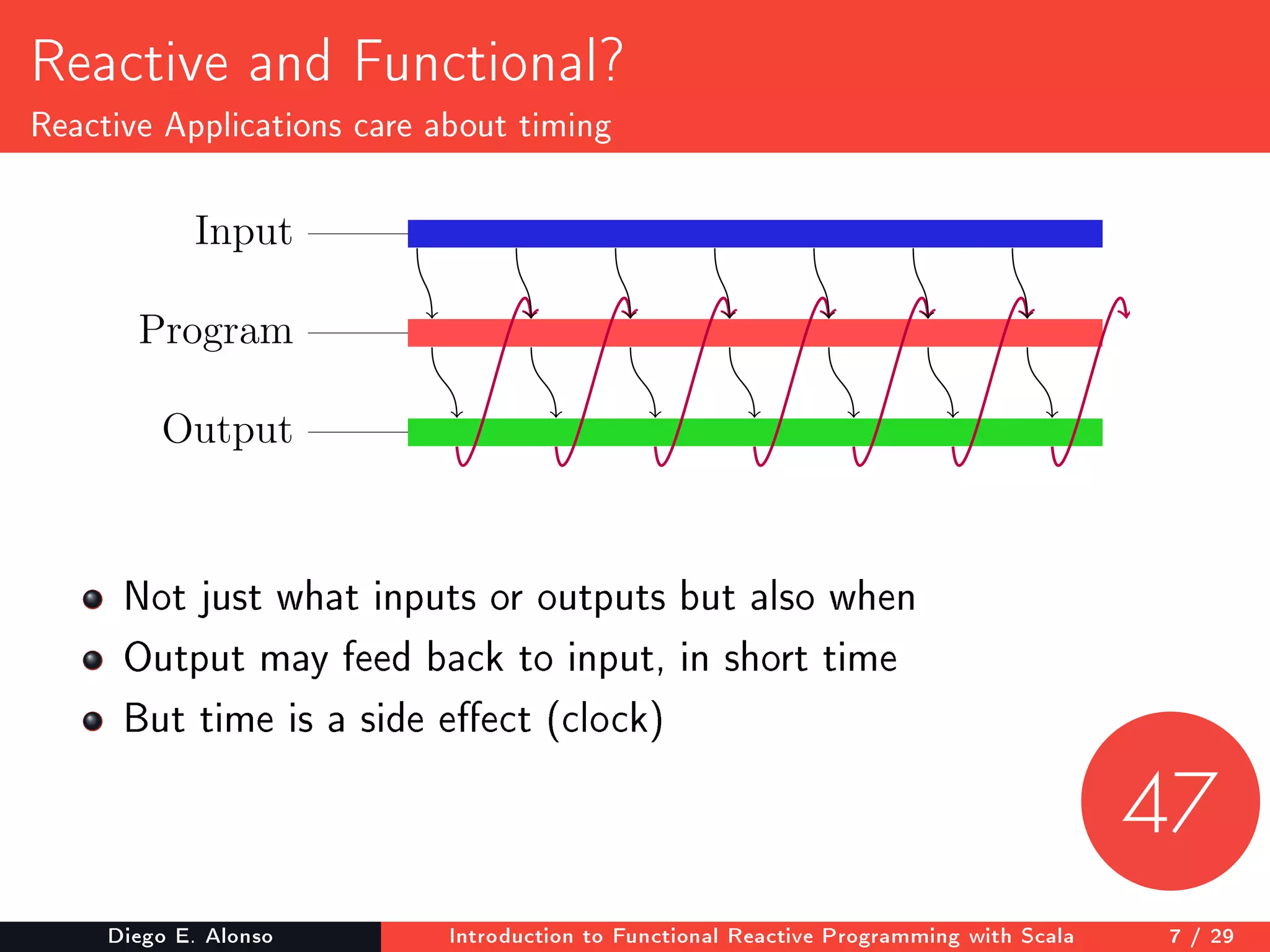
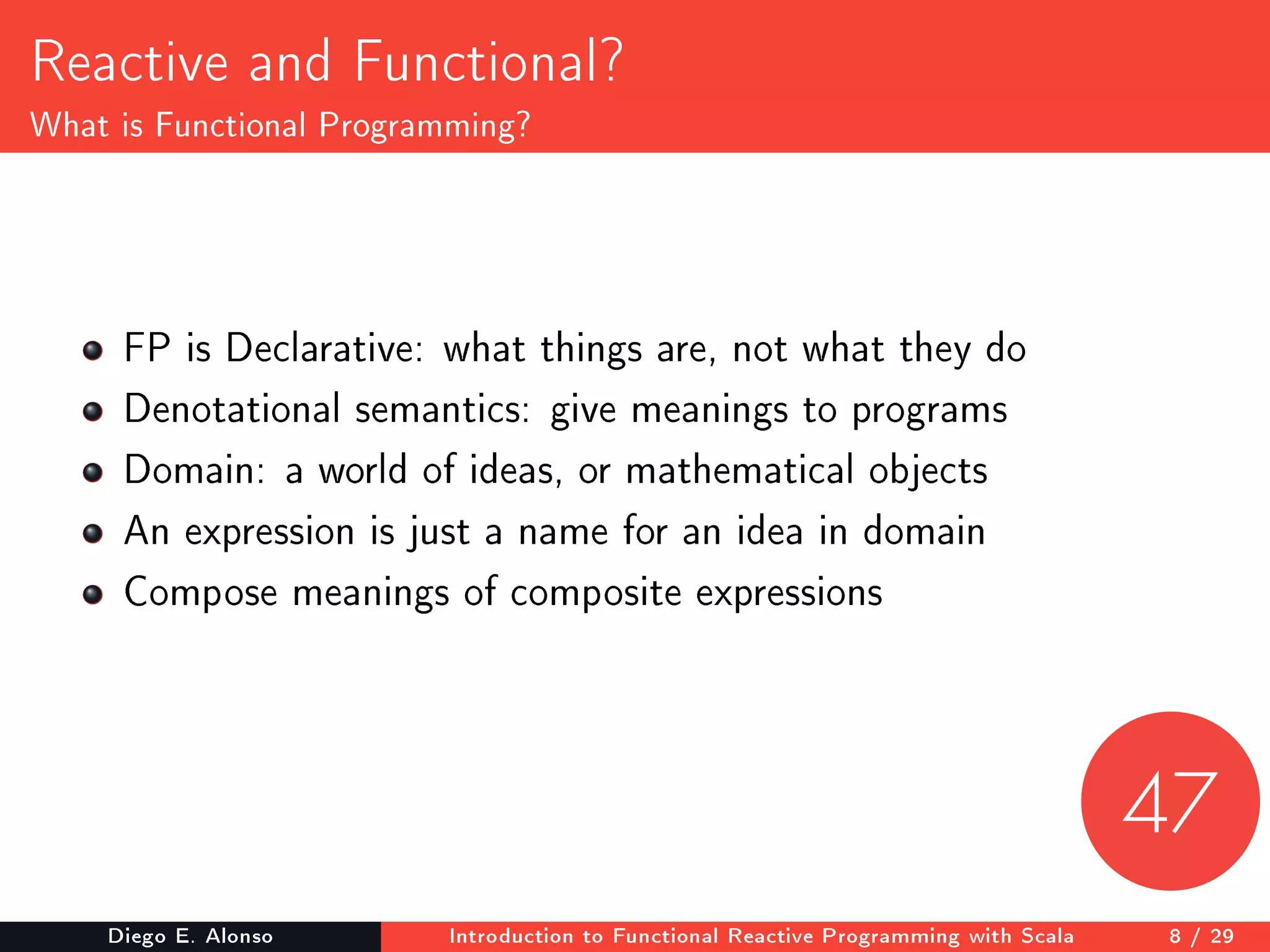
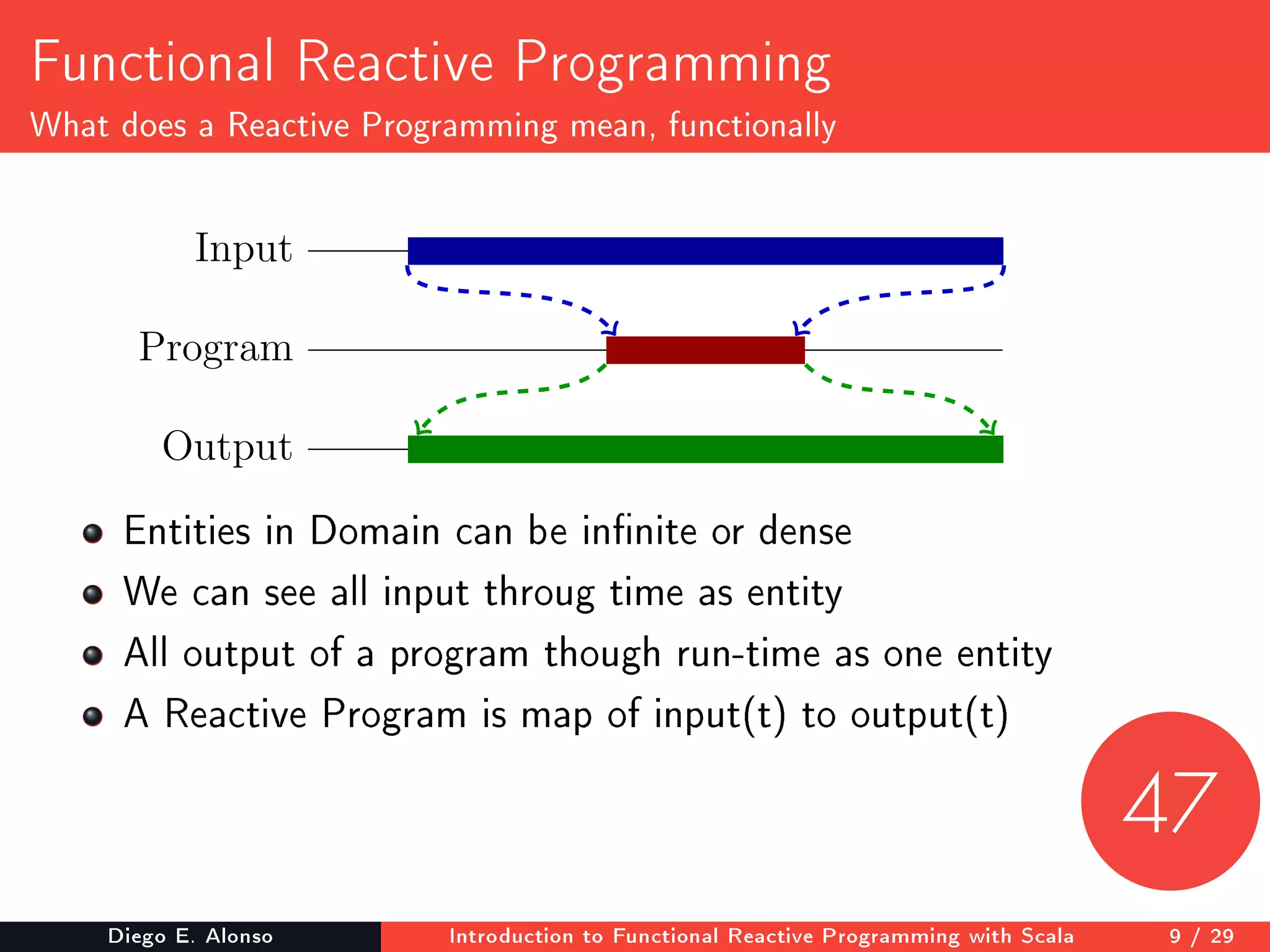
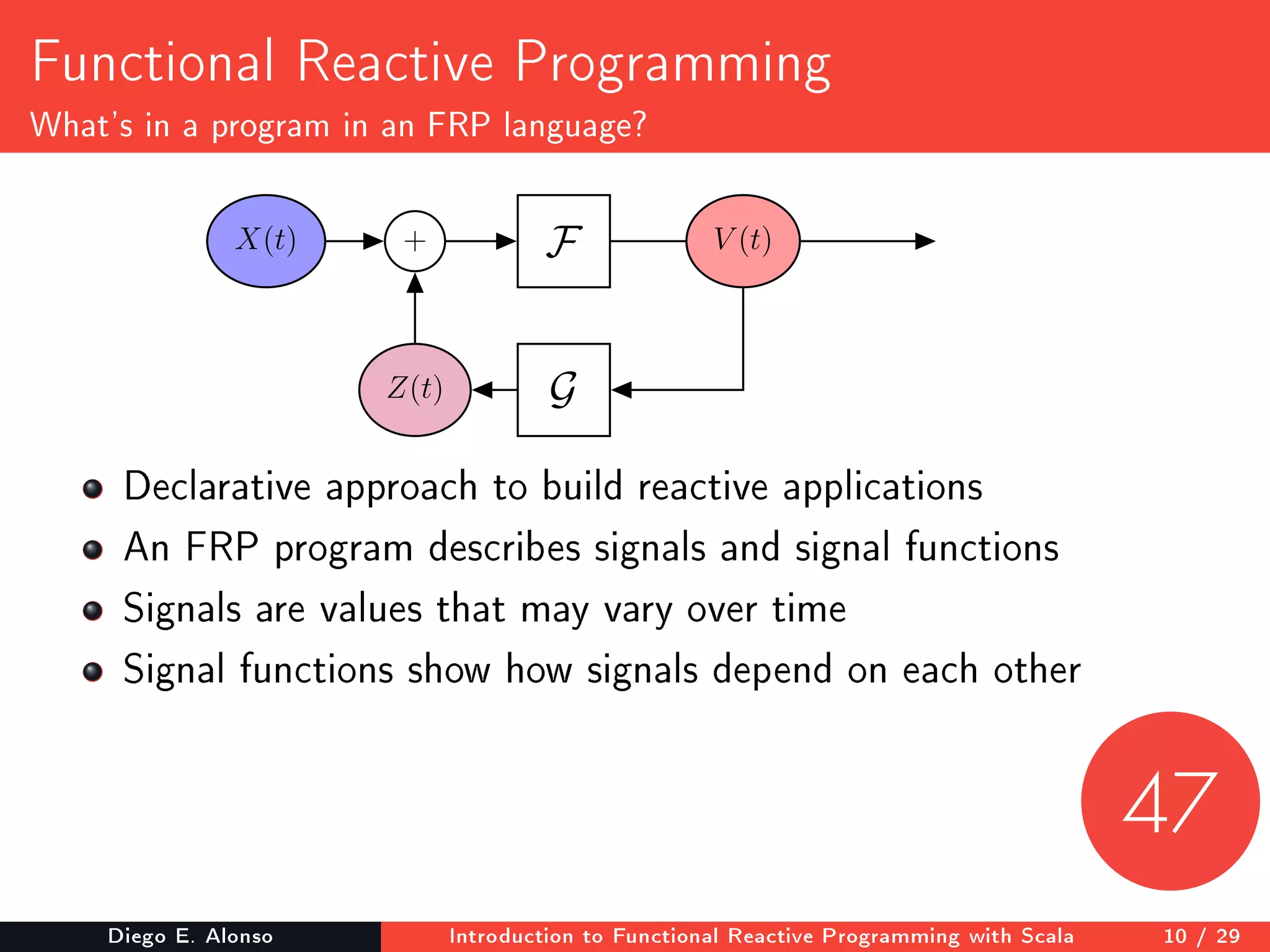
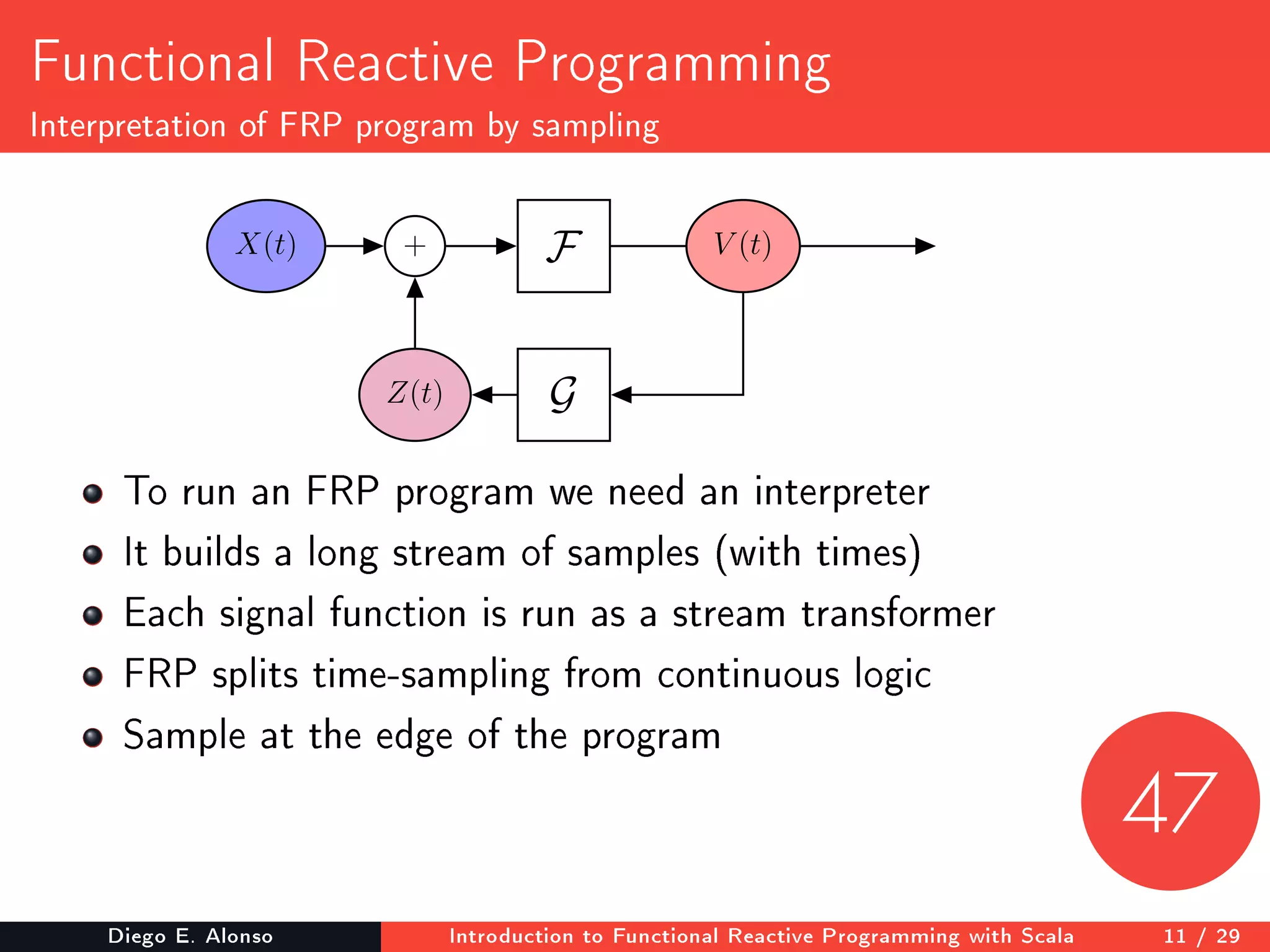
![Arrowised Functional Reactive Programming
Simple FRP uses combinators of signals
X(t) +
Z(t)
F V (t)
G
Classic FRP works at the level of Signals: Sig[X]
Transform value of signal using function
Combine values of xed independent signals
Use value of signal to build another signal
Use value of signal to control which other signal follows
These is done with operations of Monad typeclass
Diego E. Alonso Introduction to Functional Reactive Programming with Scala 12 / 29](https://image.slidesharecdn.com/introtofrpscalascalax2018-181217172304/75/Intro-to-Functional-Reactive-Programming-In-Scala-12-2048.jpg)
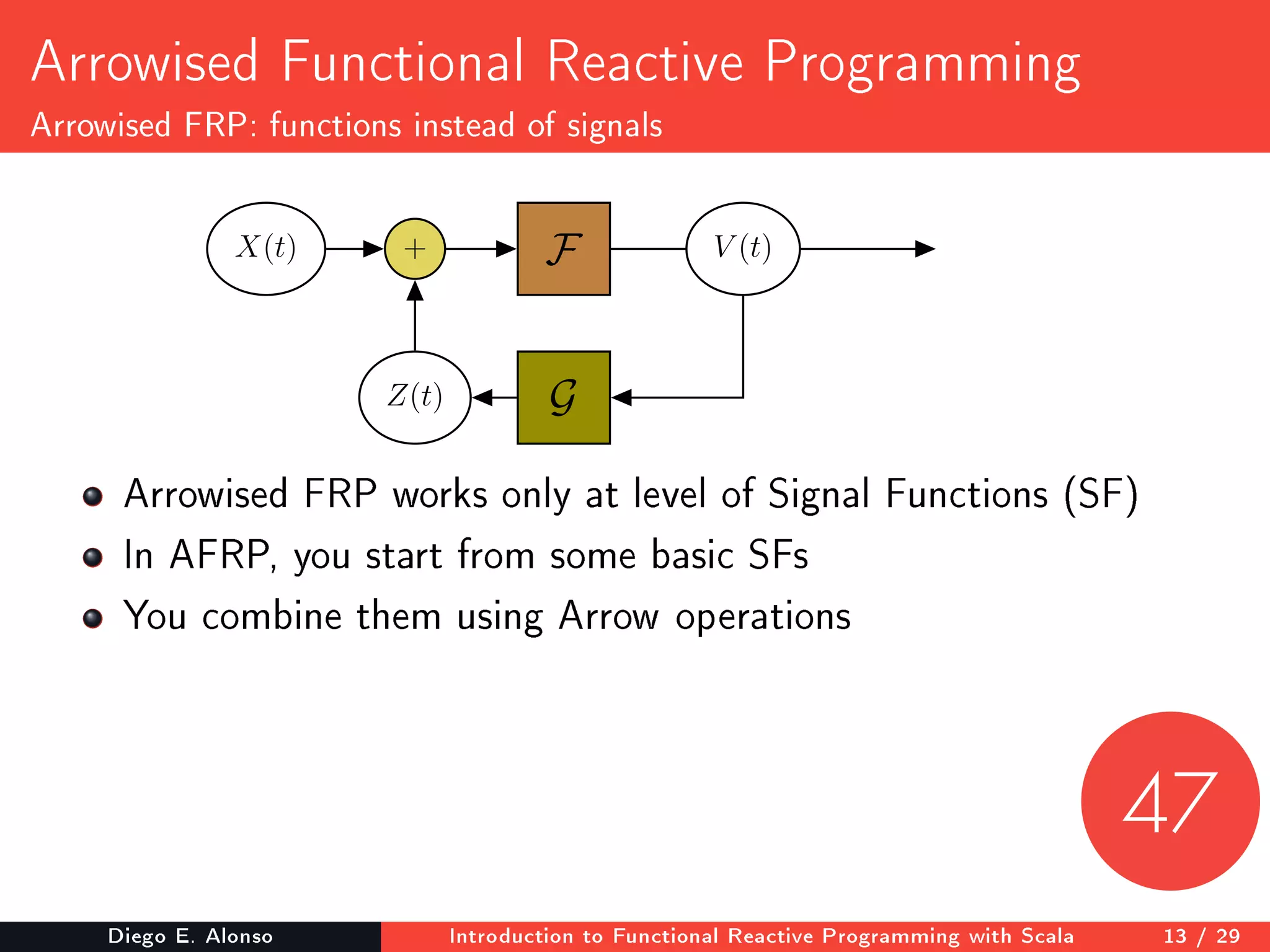
![Arrowised Functional Reactive Programming
The Arrow Type Class
X(t) +
Z(t)
F V (t)
G
Monad is class for types F[V ] of values V in eect F,
it gives operations to make F-values from F-values
Arrow is class for types A[I, O] of A-functions from I to O
with operations to transform A-functions into A-functions
Mix A-functions into an A-function on tuples or eithers
Compose A-functions into a single one
Diego E. Alonso Introduction to Functional Reactive Programming with Scala 14 / 29](https://image.slidesharecdn.com/introtofrpscalascalax2018-181217172304/75/Intro-to-Functional-Reactive-Programming-In-Scala-14-2048.jpg)
![From Lists to Monadic Stream Functions
Starting from a Scala List
sealed trait List[T]
case class Nil[T]() extends List[T]
case class Cons(head: T, tail: List[T]
The data type marks end or continuation
Backed by a data structure
Diego E. Alonso Introduction to Functional Reactive Programming with Scala 15 / 29](https://image.slidesharecdn.com/introtofrpscalascalax2018-181217172304/75/Intro-to-Functional-Reactive-Programming-In-Scala-15-2048.jpg)
![From Lists to Monadic Stream Functions
Scala Lists as a trait with two methods
trait List[T] {
def head: Option[T]
def tail: Option[List[T]]
}
Methods need not be backed by data structure
The Option marks if it is the end of list
Diego E. Alonso Introduction to Functional Reactive Programming with Scala 16 / 29](https://image.slidesharecdn.com/introtofrpscalascalax2018-181217172304/75/Intro-to-Functional-Reactive-Programming-In-Scala-16-2048.jpg)
![From Lists to Monadic Stream Functions
Lists as traits with a single methods
trait List[T] {
def uncons: Option[(T, List[T])]
}
trait InfList[T] {
def uncons: Id[(T, InfList[T])]
}
In eect, Option means may-terminate, and Id that not
Diego E. Alonso Introduction to Functional Reactive Programming with Scala 17 / 29](https://image.slidesharecdn.com/introtofrpscalascalax2018-181217172304/75/Intro-to-Functional-Reactive-Programming-In-Scala-17-2048.jpg)
![From Lists to Monadic Stream Functions
Monadic Streams: generic sequence of eectful steps
trait MonSt[F[_], T] {
def uncons: F[(T, MonSt[F, T])]
}
Monadic streams are generic on the eect
The eect covers both the head and the tail of the stream
Instances of MonSt can include state, and pass new state in tail
Diego E. Alonso Introduction to Functional Reactive Programming with Scala 18 / 29](https://image.slidesharecdn.com/introtofrpscalascalax2018-181217172304/75/Intro-to-Functional-Reactive-Programming-In-Scala-18-2048.jpg)
![Monadic Stream Functions
Denition of the Monadic Stream Functions trait
trait MoSF[F[_], In, Out] {
def apply(i: In): F[(Out, This)]
type This = MoSF[F, In, Out]
}
takes an input In, and runs computation in F
that returns value Out and a continuation
An instance of MoSF can have inner state
the instance of continuation has next state
Generalises lists, monadic streams, and sinks
Diego E. Alonso Introduction to Functional Reactive Programming with Scala 19 / 29](https://image.slidesharecdn.com/introtofrpscalascalax2018-181217172304/75/Intro-to-Functional-Reactive-Programming-In-Scala-19-2048.jpg)
![Monadic Stream Functions
Basic and stateless MoSF
Basic constructors: make a MoSF[F, I, O] from
Value Type Function Type
Eectless pure O arr I ⇒ O
Eectful liftM F[O] arrM I ⇒ F[O]
pure is an MoSF that always returns given value
arr is an MoSF that always applies given function
liftM is an MoSF that always perform given F
arrM is an MoSF that applies given computation
Diego E. Alonso Introduction to Functional Reactive Programming with Scala 20 / 29](https://image.slidesharecdn.com/introtofrpscalascalax2018-181217172304/75/Intro-to-Functional-Reactive-Programming-In-Scala-20-2048.jpg)
![Monadic Stream Functions
arr: return result of function
case class arr[F[_]: App, I, O]( fun: I = O)
extends MoSF[F, I, O] { self =
def apply(i: I): F[(O, This)] =
( fun(i) - self ).pure
}
case class liftM[F[_]: Functor, I, O](fo: F[O])
extends MoSF[F, I, O] { self =
def apply(i: I): F[(O, This)] =
fo.map( o = o - self )
}
// type This = MoSF[F, I, O]
Diego E. Alonso Introduction to Functional Reactive Programming with Scala 21 / 29](https://image.slidesharecdn.com/introtofrpscalascalax2018-181217172304/75/Intro-to-Functional-Reactive-Programming-In-Scala-21-2048.jpg)
![Monadic Stream Functions
ap: merge input-wise two independent MoSF
def ap[F[_]: App, In, Mid, Out](
sffun: MoSF[F, In, Mid = O],
sfmid: MoSF[F, In, Mid]
): MoSF[F, In, Out] =
(i: In) = App[F].map2(sffun(i), sfmid(i)) {
case ( (fun, fkont), (arg, mkont) ) =
fun(arg) - ap(fkont, mkont)
}
Diego E. Alonso Introduction to Functional Reactive Programming with Scala 22 / 29](https://image.slidesharecdn.com/introtofrpscalascalax2018-181217172304/75/Intro-to-Functional-Reactive-Programming-In-Scala-22-2048.jpg)
![Monadic Stream Functions
andThen: pass output to another MoSF
def andThen[F[_]: Monad, In, Mid, Out](
mosf: MoSF[F, In, Mid],
post: MoSF[F, Mid, Out]
): MoSF[F, In, Out] =
(i: In) = for {
(m, mosfK) - mosf(i)
(o, postK) - post(m)
} yield o - andThen(mosf, postK)
Continuation is composition of continuations
Diego E. Alonso Introduction to Functional Reactive Programming with Scala 23 / 29](https://image.slidesharecdn.com/introtofrpscalascalax2018-181217172304/75/Intro-to-Functional-Reactive-Programming-In-Scala-23-2048.jpg)
![Monadic Stream Functions
rst: pair inputs and output of MoSF with extra
def first[F[_]: Functor, In, Out, eX](
mosf: MoSF[F, In, Out]
): MoSF[F, (In,eX), (Out,eX)] = {
case (i, x) =
mosf(i) map { case (o, cont) =
(o, x) - cont.first
}}
applies mosf to the rst element
pairs it with the second element
Diego E. Alonso Introduction to Functional Reactive Programming with Scala 24 / 29](https://image.slidesharecdn.com/introtofrpscalascalax2018-181217172304/75/Intro-to-Functional-Reactive-Programming-In-Scala-24-2048.jpg)
![Monadic Stream Functions
left: handle case Left, pass Right through
case class left[F[_]: App, I, O, X](
mosf: MoSF[F, I, O]
) extends MoSF[F, I or X, O or X] { self =
def apply(iox: I or X): M[(O or X, This)] =
iox match {
case Right(x) =
(Right(x) - self).pure
case Left(i) = mosf(i).map {
case (o, cont) = Left(o) - cont.left
}
// type This = MoSF[I or X, O or X]
} // type or[A,B] = Either[A,B]
Diego E. Alonso Introduction to Functional Reactive Programming with Scala 25 / 29](https://image.slidesharecdn.com/introtofrpscalascalax2018-181217172304/75/Intro-to-Functional-Reactive-Programming-In-Scala-25-2048.jpg)
![Monadic Stream Functions and Monadic Streams
Can we make a MoSF from Monadic Stream
trait MoSF[F[_], I, O] {
def apply(i: I): F[(O, MoSF[F, I, O])]
}
trait MoSt[G[_], T] {
def uncons: G[ (T, MoSt[G,T]) ]
}
// type MoSt[G[_], T] = MoSF[G, Unit, O]
// type MoSF[F[_], I, O] = MoSt[ ******* , *]
So, MoSt[G, T] is just a MoSF[G, Unit, T]
Can we make a MoSF on top of a MoST?
Diego E. Alonso Introduction to Functional Reactive Programming with Scala 26 / 29](https://image.slidesharecdn.com/introtofrpscalascalax2018-181217172304/75/Intro-to-Functional-Reactive-Programming-In-Scala-26-2048.jpg)
![Monadic Stream Functions and Monadic Streams
YES, if we integrate the input into the eect of stream
trait MoSF[F[_], I, O] {
def apply(i: I): F[(O, MoSF[F, I, O])]
}
trait MoSt[G[_], T] {
def uncons: G[ (T, MoSt[G,T]) ]
}
// type MoSt[G[_], T] = MoSF[G, Unit, O]
// type MoSF[F[_], I, O] = MoSt[ Kl[F,I,?], O]
// type Kl[F[_], I, O] = I = F[O]
Diego E. Alonso Introduction to Functional Reactive Programming with Scala 27 / 29](https://image.slidesharecdn.com/introtofrpscalascalax2018-181217172304/75/Intro-to-Functional-Reactive-Programming-In-Scala-27-2048.jpg)
